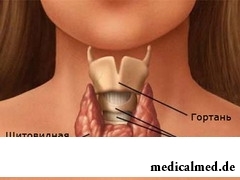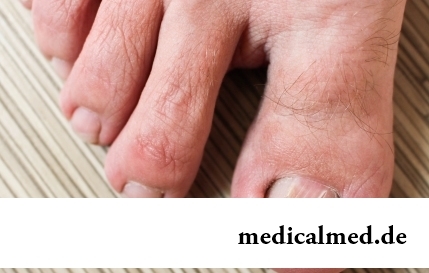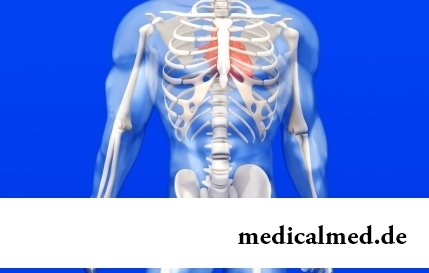





Diffusion toxic craw
Diffusion toxic craw (Greyvs's disease, Bazedova a disease) – the disease which is followed by increase in sizes of a thyroid gland and excess production of hormones  therefore there is a disturbance of all types of energy and a metabolism in an organism, and also functions of various bodies and systems.
therefore there is a disturbance of all types of energy and a metabolism in an organism, and also functions of various bodies and systems.
Origins of a diffusion toxic craw
The reason of development of the Bazedovy disease is precisely unknown. The leading role is assigned to disturbance of immune system.
Most often the disease develops as a result of autoimmune processes in an organism when in addition to normal cells of a healthy organism the immune system synthesizes the specific antibodies injuring healthy cells. So, at Greyvs's disease there is a synthesis of abnormal protein which provokes a thyroid gland to hard work.
The disease is followed by a syndrome of the thyrotoxicosis caused by long and resistant excessive quantity in an organism of hormones of thyroxine and triiodothyronine.
It is possible to meet a diffusion toxic craw at women, approximately by 8 times more often more often than at men. Preferential the disease develops in the middle age (30-50 years), but occurs also at teenagers and young people, during pregnancy and a menopause.
Degrees of a diffusion toxic craw
On weight of a course of a thyrotoxicosis distinguish three degrees of a diffusion toxic craw: easy, average and heavy. And on degree of an enlargement of the thyroid gland the disease is divided into 5 stages:
- 1 stage – a thyroid gland is practically not palpated;
- 2 stage – when swallowing a thyroid gland clearly are visible;
- 3 stage – the craw is swept up by a naked eye;
- 4 stage – sharply expressed craw;
- 5 stage – a craw of very big sizes.
Symptoms of a diffusion toxic craw
At easy degree of a diffusion toxic craw are noted the increased nervous irritability, decrease in working capacity, tachycardia (to 100 beats per minute), decrease in body weight (for 10-15% from initial).
At a moderately severe disease the increased nervous irritability belongs to characteristic symptoms of a diffusion toxic craw significantly, tachycardia makes up to 120 beats per minute, working capacity is practically lost, the person grows thin for 20% and more from initial body weight.
The heavy thyrotoxicosis is characterized by strong weight loss (50% of body weight), severe tachycardia (more than 120 beats per minute), heavy nervous irritability. The ciliary arrhythmia, psychoses, heart failure, thyrocardiac damage of a liver is also characteristic of patients with a heavy thyrotoxicosis.
Besides, symptoms of a diffusion toxic craw are expressed by the following manifestations which are classified as:
- Eye symptoms. At the Bazedovy disease it is often possible to observe uniform expansion of a palpebral fissure that makes an impression of an amazed look (protruding eyes). At severe forms of a disease the inflammation of a cornea, a helcoma which create threat to sight is possible.
- Cardiovascular symptoms. The most common symptom – tachycardia. Pulse rate can fluctuate from 90 to 120 and more beats per minute. Development of cardiovascular insufficiency is characteristic of Greyvs's disease that is followed by the expressed hypostases of extremities, cutaneous dropsies, ascites.
- Dermatological symptoms. At the Bazedovy disease the increased perspiration, an erythema, destruction of nails, hypostases standing is observed.
- Symptoms from the alimentary system. Essential increase in appetite is noted. It is connected with acceleration of a metabolism. Because of increase in motility of intestines patients quite often have a diarrhea. Disturbance of work of a liver is observed, up to development of cirrhosis.
- Endocrine symptoms. Depression of function of bark of adrenal glands and gonads is observed, the diabetes mellitus can develop. At women of childbearing age reduction of frequency and quantity of periods is observed.
- Neurologic symptoms. The most common symptoms of a diffusion toxic craw are the increased fussiness, reactivity, excitability, the general motive concern. Trembling of fingers, muscular weakness, a headache is characteristic of patients.
- Dental symptoms. Often the disease is followed by multiple caries, sometimes periodontosis.
Complications of a diffusion toxic craw
 The heaviest complication of a disease is thyrocardiac crisis. Its emergence is promoted by the following factors:
The heaviest complication of a disease is thyrocardiac crisis. Its emergence is promoted by the following factors:
- lack of adequate treatment of the Bazedovy disease throughout a long span;
- the strengthened exercise stress;
- the difficult situation which caused a severe stress or a mental injury;
- any operative measures;
- treatment of a craw by means of a radioiodine, and also surgical treatment of a craw without preliminary medicamentous compensation;
- infectious diseases.
At thyrocardiac crisis the excessive amount of thyroid hormones comes to blood that causes extremely severe defeats of cardiovascular and nervous systems, a liver and adrenal glands.
Diagnosis of a diffusion toxic craw
To define a disease does not present special difficulty. Confirm the diagnosis by means of laboratory blood analyses on the level of content of thyroid hormones. Also in blood the increased concentration of iodine and reduced amount of cholesterol is observed.
If in the presence of thyrotoxicosis symptoms the thyroid gland is not probed, its atypical arrangement is probable. However it is necessary to know that symptoms of a thyrotoxicosis can be shown also at other diseases: the mixed and nodal craw, a thyroiditis, cancer and a tumor of a thyroid gland.
Treatment of a diffusion toxic craw
For performing effective therapy it is extremely important to provide to the patient quiet conditions and to adjust a healthy sleep. Food has to be full, with the increased content of vitamins and proteins. Treatment of a diffusion toxic craw can be medicamentous or using a radioiodine. At severe forms of a disease the surgical method of treatment is preferable.
Drug treatment of a diffusion toxic craw, as a rule, quite long. The doctor appoints anti-thyroid drugs, the potassium drugs derivative of thiouracil and an imidazole, iodine drugs, demulcents. The minimum duration of therapy makes half a year. Generally the patient accepts medicines for 1 - 1,5. If medicamentous therapy does not yield positive takes, it is necessary to consider other methods of treatment.
Radioyodoterapiya – quite effective method of treatment which has, however, a set of contraindications which the peptic ulcer, tuberculosis, mental disorders, pregnancy and the period of feeding by a breast are among.
Surgical treatment of a diffusion toxic craw is preferable in the presence of allergic reactions, too big increase in a craw (the 3rd degree above), and also at too expressed symptoms of cardiovascular insufficiency.
The stomach of the person not bad copes with foreign objects and without medical intervention. It is known that the gastric juice is capable to dissolve even coins.

When overcomes feeling of hunger, and an opportunity to have dinner fully is absent, having a snack − small on volume comes to the rescue...
Section: Articles about health
The word "onikhokriptoz" is unfamiliar to most of people, meanwhile quite so physicians call very widespread problem: the growing of edge of a nail into surrounding fabrics causing inflammatory process. Usually the illness affects thumbs of legs, and is followed покр...
Section: Articles about health
Dogrose – one of the most widespread adornment and medicinal plants growing practically in all territory of our country. To most of Russians it is a beautiful bush it is known, first of all, as a source of fruits, extremely vitamin-rich. However curative properties of a dogrose are not limited to it at all. About how still it is possible to use a plant in the medical purposes, we will tell today....
Section: Articles about health
Extracorporal fertilization – one of the most modern methods of controlling with infertility. So far it already helped znach...
Section: Articles about health
Hemorrhoids – extremely widespread disease. Periodically arising inflammations and bleeding of hemorrhoidal nodes cause serious discomfort to nearly fifteen percent of adults. Meanwhile, having a clear idea of the aggravation reasons...
Section: Articles about health
Scientists have no unambiguous opinion on a proximate cause of emergence of a carcinoma cutaneum today. Only the factors promoting development of this illness are precisely established. Treat them: long impact on skin of ultraviolet rays, radiation exposure, thermal injuries, injuries of skin by aggressive chemicals (pitches, acids, alkalis, etc.), genetic predisposition (existence of malignant new growths of skin in the family anamnesis), at...
Section: Articles about health
Each woman has preferences in the field of use of those goods which help us to look good, feel се...
Section: Articles about health
What is in our understanding weeds? It plants which are considered to be suitable only for compost pits and feeding of animals. Meanwhile, among the weeds growing literally under legs it is possible to find the mass of the officinal herbs possessing invaluable Paul...
Section: Articles about health
About 10-15 years ago existence of the computer in the apartment of the Russian was considered as a rarity and office rooms were only at the first stage of equipment by these useful devices. Today practically in each house there is a computer (and often not one), and a regular user is already every our second compatriot. Convenience and efficiency of personal computers are undoubted, but the people working with them daily have to know also about health hazard which they can predstavlit...
Section: Articles about health
With age in a human body harmful substances collect. We receive them with food and water, at inhalation contaminated air...
Section: Articles about health
Each person knows that fervescence is an illness sign. However too low temperature (hypothermia), especially also can demonstrate existence of diseases when it is observed long enough. Such state is dangerous those...
Section: Articles about health
Water with a lemon - idle time in preparation drink which supporters of a healthy lifestyle already managed to appreciate. Used in a warm look and on an empty stomach, it is one of the most useful prophylactics allowing to prevent tens of diseases and just to raise an organism tone. Especially effectively to use warm water with lemon juice after a serious illness, during a season of the colds, and also to children, old men and pregnant women which do not have contraindications...
Section: Articles about health
Stability of a hormonal background is one of the most important conditions of preservation of health of the woman. At the same time endocrine system –...
Section: Articles about health
Run - one of the most available and effective ways to revitalize the organism. Knowing about its extraordinary advantage, each of us at least once tried to make jogs, but only the few made these occupations regular. In spite of the fact that in jogging (easy an ozdor...
Section: Articles about health
According to data of World Health Organization, the cataract is diagnosed almost for 7% of the population of Earth. The statistics of incidence is considered not full as at an initial stage the illness, as a rule, does not cause to the person of special inconveniences, and many diseased sees doctors not at once. The cataract is not only one of the most widespread ophthalmologic illnesses, but also the reason of a half of cases of loss of sight....
Section: Articles about health
The climax, or menopause is the normal process of the termination of genital function of the woman which is followed serious hormonal...
Section: Articles about health
Almost each of us during life faced dissatisfaction with own body. At such moments, as a rule, we begin to shame ourselves, urgently we go on the most rigid diet promising minus of 10 kg in a week, or we exhaust ourselves in the gym to полусм...
Section: Articles about health
Weakness of an ankle joint – very widespread problem. Its existence is demonstrated by tendency to a podvorachivaniye of legs when walking on heels, frequent painful sprains, pain on average and anonymous toes even after small loadings. Usually people with such pathology take off unpleasant effects by means of the anesthetizing pulverizing and ointments, but it does not lead to radical elimination of a problem. Meanwhile, at the known persistence it is possible to strengthen an ankle to the house...
Section: Articles about health
All got used long ago that, having addressed the plastic surgeon, it is possible to modify natural parameters of a figure or to reduce...
Section: Articles about health
Statistically, pathologies of a thyroid gland in the world more than 500 million people have. Failures in work of this body lead to heavy disbolism, development of heart diseases, vessels, a reproductive and nervous system. In hard cases excessive...
Section: Articles about health
The majority of gynecologic diseases prove three main signs, each of which speaks about need of a visit to the gynecologist. Certainly, it is possible to establish the exact diagnosis only after inspection, but on the basis of some signs it is possible to assume existence of this or that pathology. Let's consider symptoms of the female diseases which are found most often....
Section: Articles about health
For many women the word "fat" sounds as a sentence. In aspiration to an ideal figure they try to exclude, first of all, from with...
Section: Articles about health
It seems, quite recently you brought the baby from maternity hospital, but time flew by, and here it is already going to join the first in life children's collective. How to prepare the child for visit of a garden? What needs to teach him to facilitate process адап...
Section: Articles about health
Quite large number of people adheres to the principles of vegetarian food. But how to be if in a family of vegetarians there are children? Whether it is possible to eat also it the same as to parents, or after all the children's organism is not adapted for the use of exclusively vegetable food? Let's try to understand....
Section: Articles about health
Residents of big cities quite often have a disease which is known as the syndrome of chronic fatigue (SCF) today. This illness...
Section: Articles about health
Cold, puffiness of a nose, itch, the watering eyes - characteristic symptoms of the allergic rhinitis resulting from hit of allergens (pollen, house dust, hair of animals, etc.) on a mucous membrane of a nose. Unpleasant feelings often deliver беспоко...
Section: Articles about health
Not without reason doctors say that 90% of diseases begin or develop because of misoperation of intestines. Disturbance of its functions is connected with various factors among which the important place belongs to excessive "clutter" of an intestinal path. In an organism not only the remains of food, but also mass of harmful substances which we with food accepted accumulate. Accepted to accept, and about that to remove them, did not take care. And in it a problem....
Section: Articles about health
